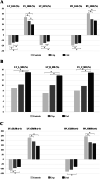Detection of subclinical myocardial dysfunction in cocaine addicts with feature tracking cardiovascular magnetic resonance
- PMID: 32981526
- PMCID: PMC7520970
- DOI: 10.1186/s12968-020-00663-7
Detection of subclinical myocardial dysfunction in cocaine addicts with feature tracking cardiovascular magnetic resonance
Abstract
Background: Cocaine is an addictive, sympathomimetic drug with potentially lethal effects. We have previously shown with cardiovascular magnetic resonance (CMR) the presence of cardiovascular involvement in a significant percentage of consecutive asymptomatic cocaine addicts. CMR with feature-tracking analysis (CMR-FT) allows for the quantification of myocardial deformation which may detect preclinical involvement. Therefore, we aimed to assess the effects of cocaine on the left ventricular myocardium in a group of asymptomatic cocaine users with CMR-FT.
Methods: In a cohort of asymptomatic cocaine addicts (CA) who had been submitted to CMR at 3 T, we used CMR-FT to measure strain, strain rate and dyssynchrony index in CA with mildly decreased left ventricular ejection fraction (CA-LVEFd) and in CA with preserved ejection fraction (CA-LVEFp). We also measured these parameters in 30 age-matched healthy subjects.
Results: There were no differences according to age. Significant differences were seen in global longitudinal, radial and circumferential strain, in global longitudinal and radial strain rate and in radial and circumferential dyssynchrony index among the groups, with the lowest values in CA-LVEFd and intermediate values in CA-LVEFp. Longitudinal, radial and circumferential strain values were significantly lower in CA-LVEFp with respect to controls.
Conclusions: CA-LVEFp show decreased systolic strain and strain rate values, with intermediate values between healthy controls and CA-LVEFd. Signs suggestive of dyssynchrony were also detected. In CA, CMR-FT based strain analysis can detect early subclinical myocardial involvement.
Keywords: Cardiovascular magnetic resonance; Cocaine; Feature tracking; Heart failure; Subclinical dysfunction.
Conflict of interest statement
The authors declare that they have no competing interests.
Figures



References
-
- European Drug Report 2016. Trends and Developmenents. European monitoring centre for drugs and drug addiction, vol. 2016. Luxembourg; 2016.
-
- Kozor R, Grieve S, Buchholz S, Kaye S, Darke S, Bhindi R, et al. Regular cocaine use is associated with increased systolic blood pressure, aortic stiffness and left ventricular mass in young otherwise healthy individuals. PLoS One. 2014;9:e89710. doi: 10.1371/journal.pone.0089710. - DOI - PMC - PubMed
MeSH terms
LinkOut - more resources
Full Text Sources
Medical

